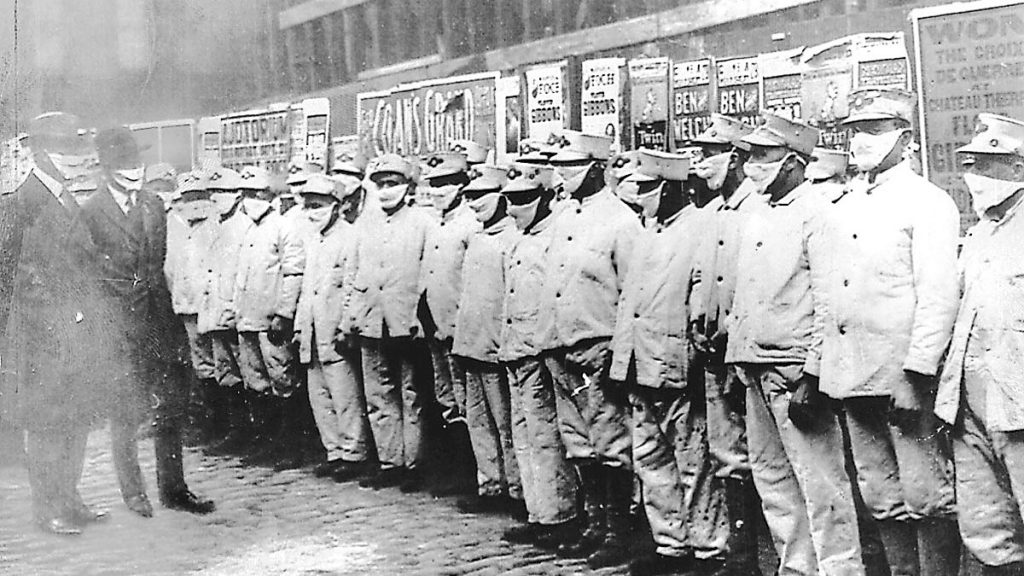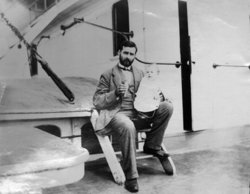
Climb the ladder, from bottom to top. Influenza waits at every rung.
From one family.
A Polish family lives in Winona, Minnesota. A doctor visits their home and is shocked at the sight—both parents and all ten of their children suffer from influenza today. The doctor looks around the house and sees next to nothing of anything. Little food, few household goods, a couple of items of clothing, broken-down furniture. The entire scene points to a dismal future whether measured in hours or days.
From one family to many families.
A group of families comprise Tylerdale, a neighborhood in Washington, Pennsylvania. They’re staggering under a shock of their own—57 new cases hit this community hard just today.
From one neighborhood to a town.
An entire town, Mascoutah, Illinois is “The Center of Influenza Epidemic in St. Clair County with Three Hundred Cases,” according to the headline in a local newspaper.
From a town to a county.
Coles County, Illinois is on alert because there’s no more Vicks VaPo Rub on the shelves of local stores. The supply was expected to last for another three months. People had grown to rely on the thick paste as one of the few things they could do—that they controlled—to provide comfort to influenza patients.
From a rural county to the big city.
The city of Philadelphia, Pennsylvania looks up and dreads what it feels. Rain falls through unusually warm air. Any other year in late October and the sensation would be invigorating. Today the drops seem like a death sentence. Residents are certain influenza will now be worse.
And, along the way, on October 21, 1918, people respond. They reveal so much of themselves in this day of challenge, of weariness, of dragging through the endlessness. Who they are becomes apparent, a day at a time.
Lucy Durr writes to her son. She is helping the nurses at Camp Sheridan, in Montgomery, Alabama. “I feel humble in the presence of trained women,” she confesses.
A doctor stalks through one of the patient wards at the Great Lakes Naval Training Station north of Chicago, Illinois. Confident, straight as a rod, and larger-than-life, he’s credited with having invented spinal forceps. He’s also obsessed with hunting and fishing and any struggle outdoors. He writes to his son in language exquisitely suited to the father: “Influenza epidemic gives me a feast.” Someone calls his name. The doctor scribbles his signature, addresses the envelope, and into the mail it goes for the long journey to his son in Milan, Italy. Dr. Clarence Hemingway knows his son Ernest will be glad to read the latest news.
In St. Paul, Minnesota a silence fills the air of a school board meeting. Tension. Resentment. Bad feelings. The police chief decides to speak first. He tells of his willingness to enforce the law, and for now, the law is that school will not be opened because of influenza. In the hour before this meeting, he had privately told the school board president that he would do as the local health director had asked—that the school be punished for violating the ban on school sessions. Now, having heard the police chief repeat his statement in the most polite and respectful way possible, the school board votes to reverse course and obey the ban. But it’s a pill bitterly swallowed—a board member asserts that they know more about the students’ safety than the health director does. The meeting adjourns. Back to their corners for the next round on the next day.
A thought for you on Day 44, April 25, 2020, forty-four days after President Trump declares Covid-19 a national emergency—the Minnesota meeting. Both sides think they’re doing right. Both sides believe that if the other way is adopted, the things no one wants will begin to happen. Both sides are ready and willing to do what it takes to win this fight because the stakes are high. And there’s no easy fix or safe middle, no compromise where everyone leaves happy and contented with the result yet to come. I think all of us are familiar with these draw-down clashes over the last few years. It’s part of our Warfluenza, a term I developed earlier in this Series. The fact and the reality, though, is that no one is going anywhere. Tomorrow, or next quarter, or the following year, we’ll still be together having to hash things out. The way we address each other in today’s fight will affect how we address each other in future fights. The people in the school board meeting knew this was true. They had to figure out how to make it work because they lived in proximity. They have to live near one another. Maybe that’s a glimpse of an answer far in the distance. Realizing that the proposition of living near one another is now a different proposition than it used to be.

(note to reader—I invite you to subscribe to this series/blog. The purpose of my posting in this series is the purpose of my enterprise at Historical Solutions—to explore the past in a new way that brings new and different value to you, both in the present (this minute) and on the edge of the future (what’s ahead or forward of this minute). The past is everything before now, the totality of all time before the present; history is a set of very small slices of the past that, for a particular reason, have been remembered. If you wish to contact me privately, please do not hesitate to text or call 317-407-3687)







